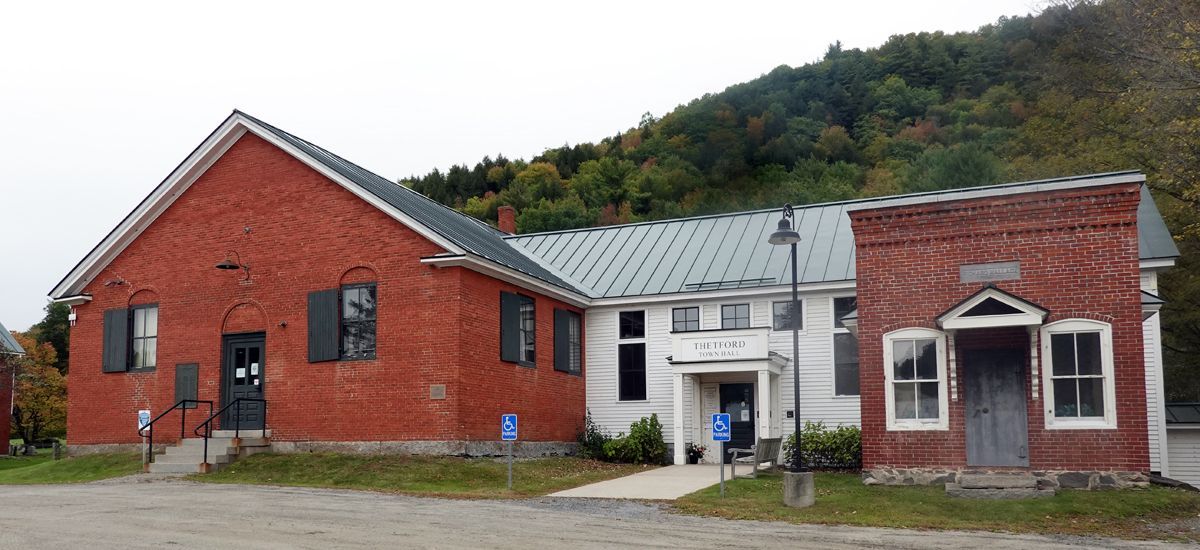Town Hall eyes the challenge of climate change
The Town can set an example others should follow, because, let’s face it, time is running out.

The Town Hall in Thetford Center is a quintessential New England brick building. It was built in 1830 after the Meeting House on Thetford Hill (now the congregational church) that had served both as Town Hall and a place of worship, was purchased in entirety by the church. The Meeting House was then rolled away from its location on the town-owned Thetford Hill Green, to its present site. This upheaval was to effect the separation of church and Town government.
The dedicated Town Hall building that we see today was built of local brick from the brickyard owned by local entrepreneur Hezekiah Porter, as was the abutting Methodist Church (now the Timothy Frost building). Since its inception, Town Hall has seen some changes and remodeling, the most recent being in 2002 when an addition was built to provide much-needed office space and to connect the stand-alone Wallace Vault to the rest of Town Hall.
It is doubtful that back in the 1800s conserving energy was much of a consideration. It was normal in the past to consume large quantities of firewood. And despite Town Hall’s twentieth-century heating system, spending time in the historically original and uninsulated Wallace Vault in the winter can be a chilling experience. The barrel-like wood stove in the vault looks outsized for that small space, but it was probably what it took to make the space cozy.
Fast forward to 2021, and we are in a new era with very different energy concerns. Governments around the world and in the State of Vermont are grappling with overheating of our planet that was born out of the industrial revolution and the mass adoption of burning coal, a fossil fuel. We arrived at the present-day crisis via a decades-long spree of exploiting coal, petroleum, and natural gas with abandon.

Nations, states, and municipalities have been adopting legislation in an attempt to stave off the worst effects of what we have wrought. In 2016 Vermont adopted a Comprehensive Energy Plan with the goal of switching Vermont to using 90% renewable energy by 2050 in order to rein in emissions of “greenhouse” gases like carbon dioxide that are produced by burning petroleum, coal, natural gas, propane, wood, etc. These gases accumulate in the earth’s atmosphere and trap heat. The chief component of natural gas, methane, is particularly good at trapping heat when unburned. In its first 20 years in the atmosphere, its capacity to trap heat is about 86 times better than that of carbon dioxide. It may account for as much as 30% of global warming since pre-industrial times. There are many sources of methane, from agricultural practices to natural gas facilities and pipelines that are often rife with leaks.
In 2020 Vermont also passed The Global Warming Solutions Act, which is currently being translated into actual legislation.
The two biggest sources of greenhouse gases in Vermont are transportation and the heating of buildings. Through our tireless Energy Committee, efforts are underway in town to reduce heating emissions by making private homes, and now the Elementary School, better insulated so they burn less fuel. What can we do at the municipal level?
For a start, our brick Town Hall, though lovely, is not particularly energy efficient. We could cut its emissions, have a more comfortable building, start on the inevitable transition to clean energy, and even save some money in the long term, by updating it with some energy efficiency measures. To understand the options and where they would be applied requires some expertise. Therefore the steering committee for the Intermunicipal Regional Energy Coordinator (whose services Thetford shares with six other VT towns) along with the Town Energy Committee’s representative, sent out a Request for Proposals to regional energy service companies (ESCOs.) These are companies that develop, design, build, maintain and help arrange financing for energy-saving projects. They also reduce cost, including the expense of operating and maintaining the system. A project built by an ESCO must be guaranteed to deliver cost savings by contract. They also offer Payment and Performance Bonds, which are like an insurance policy. If the ESCO goes out of business during construction, the insurance company pays to finish the project. Typically an ESCO can build the project at a more favorable cost than if the client contracted it out on their own and can find better financing.
The Steering Committee received two proposals and chose to go with the smaller, more local ESCO, Energy Efficient Investments based near Concord, NH. EEI will perform an energy audit of Town Hall at no cost.
Ahead of their detailed audit, EEI has already suggested some basic improvements, like door weatherstripping and a new HVAC system (heating, ventilation, air conditioner). Anyone working in Town Hall in the winter notices the uneven distribution of heat in the building. Other shortcomings to address include the door to the basement mechanical room that has to be propped open in the cold months to stop dangerous heat buildup from tripping the fire alarm. And the offices occupied by the Town Manager and the Police have both safety and energy issues: windows that do not open and no form of ventilation or cooling. With an eye to safety, EEI also recommended replacing the lighting in the basement with safe, less antiquated, and brighter fixtures.
The proposed HVAC installation would incorporate non-polluting, electric heat/cooling pumps. The propane furnace will be retained as a backup against the occasional power failure. A costly item would be a digital control unit for the whole system that is needed to coordinate the heat pumps and the propane furnace so they do not work against each other. Geoff Martin, the Intermunicipal Regional Energy Coordinator, is researching less expensive systems that are on the market.
Finding rebates and grant funding to pay for these upgrades is another of EEI’s services. Some funding might come through existing programs at Efficiency Vermont or Green Mountain Power. In addition, Vermont recently allocated $200 million of American Rescue Plan money to addressing climate change. Of that, $21 million is targeted for weatherizing Vermont’s aging housing stock. The hope is that there will be grants for municipal projects such as making our 1830 red brick and clapboard Town Hall into a model for clean energy. And if the Town sets an example others should follow, because, let’s face it, the climate clock has been ticking for decades, and time is running out.
